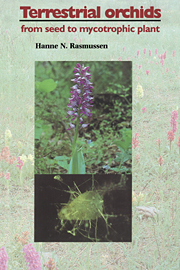Book contents
- Frontmatter
- Contents
- Acknowledgements
- Introduction
- 1 Properties of ‘dust’ seeds
- 2 Seed development
- 3 Seed survival
- 4 Requirements for germination
- 5 Fungi
- 6 Germination processes
- 7 Underground organs
- 8 Orchid mycorrhiza
- 9 Abiotic factors in growth and development
- 10 Life history and phenology
- 11 Propagation
- 12 Effects of orchid mycorrhiza
- 13 Descriptions of genera
- Appendix A Nutrient substrates mentioned in the text
- Appendix B Names and synonyms
- References
- Index
7 - Underground organs
Published online by Cambridge University Press: 13 October 2009
- Frontmatter
- Contents
- Acknowledgements
- Introduction
- 1 Properties of ‘dust’ seeds
- 2 Seed development
- 3 Seed survival
- 4 Requirements for germination
- 5 Fungi
- 6 Germination processes
- 7 Underground organs
- 8 Orchid mycorrhiza
- 9 Abiotic factors in growth and development
- 10 Life history and phenology
- 11 Propagation
- 12 Effects of orchid mycorrhiza
- 13 Descriptions of genera
- Appendix A Nutrient substrates mentioned in the text
- Appendix B Names and synonyms
- References
- Index
Summary
All underground parts of terrestrial orchids must either accommodate the endophyte or actively reject it. The mycotrophy of the protocorm is obligate, and most roots are also mycotrophic in varying degrees, but in many species the rhizome loses its mycotrophic function while the plant is still young. Storage organs such as root-stem tubers and corms are usually not infected.
An apparently important aspect of the mycotrophic organs is their longevity; although in the tuberous species some roots function for only about 9 months, orchid roots typically continue to function for a number of years.
Protocorm
The germinating embryo develops into the protocorm. Unlike other angiosperm seedlings it has no radicle, since the suspensor end of the embryo becomes specialized to form mycotrophic tissue. Neither root cap nor meristem is formed, and the suspensor end of the embryo remains stationary in the soil (Fig. 5.6, p. 111; Fig. 6.1c, p. 114; Fabre, 1856; Stojanow, 1916). As far as is known all orchid seedlings are modified to form mycotrophic tissue in the basal part, even in Bletilla which has the most highly differentiated embryo yet observed (Bernard, 1904).
The opposite, i.e. chalazal, end with the functional meristem is solely responsible for all increase in width and length in the seedling; from this end a condensed or elongated mycorhizome develops which allows the shoot tip with leaf primordia to progress in the soil.
Strictly speaking the protocorm comprises only that part of the seedling axis that develops below the lowermost leafy appendage and corresponds to the radicle and hypocotyl in seedlings of other plants. The boundary between protocorm and mycorhizome is indistinct, however, since the first scale leaves are often inconspicuous and occasionally vestigial.
- Type
- Chapter
- Information
- Terrestrial OrchidsFrom Seed to Mycotrophic Plant, pp. 120 - 141Publisher: Cambridge University PressPrint publication year: 1995



